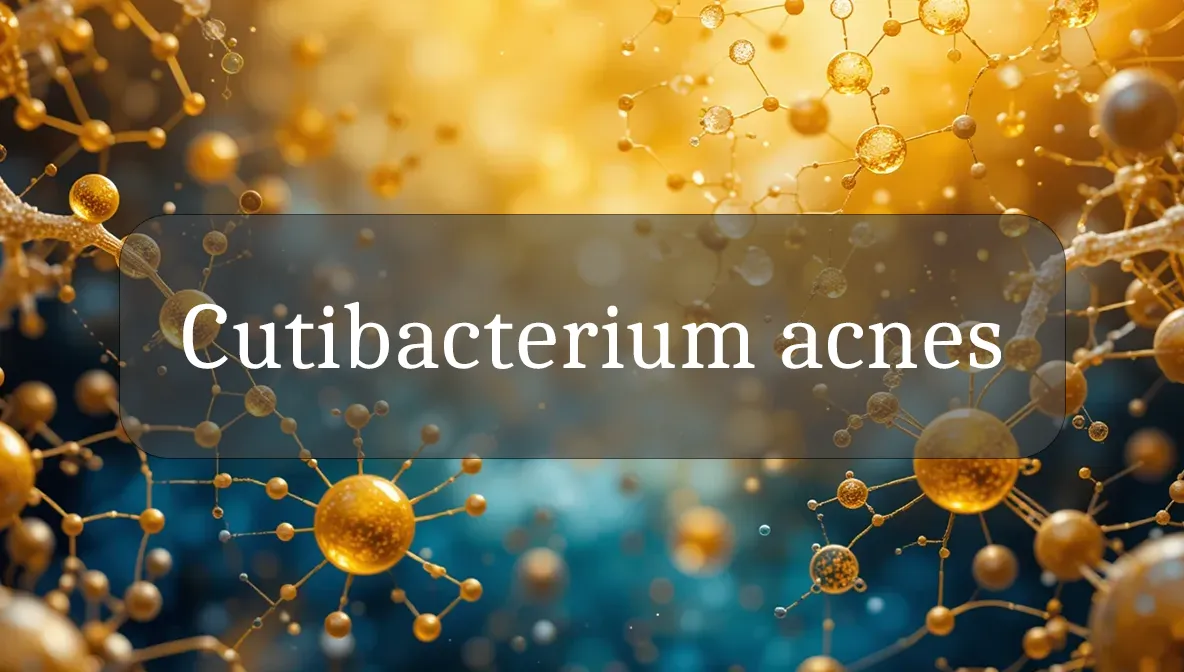Skin’s Double-Edged Bacterial Ally
Cutibacterium acnes, formerly known as Propionibacterium acnes, is like a complex neighbor on your skin—helpful in small doses but potentially problematic when out of balance. As a key part of the skin microbiome, it’s a focus for health-conscious folks aiming to maintain clear skin and overall wellness. Understanding C. acnes can empower you to make choices that support your skin’s health. Let’s explore what C. acnes is, why it matters, and how you can manage its role for daily vitality!
Chemical Identity and Type
Cutibacterium acnes is a Gram-positive, rod-shaped, aerotolerant anaerobic bacterium, meaning it thrives in low-oxygen environments like hair follicles but can tolerate some oxygen exposure. It’s a lipophilic (fat-loving) microbe that feeds on fatty acids in sebum, the oily substance produced by sebaceous glands. Part of the skin’s natural flora, it’s found in sebum-rich areas like the face, scalp, and upper back. Think of it as a resident that thrives in your skin’s oily nooks, contributing to both health and potential issues.
Biological Role and Benefits
C. acnes is a commensal bacterium that plays a dual role in skin health, offering these benefits when balanced:
- Skin Homeostasis: It helps maintain a healthy skin microbiome by competing with harmful pathogens, preventing their overgrowth (colonization resistance).
- Antioxidant Activity: C. acnes produces enzymes like RoxP, which combat oxidative stress, protecting skin cells from damage.
- Immune Modulation: It interacts with the immune system, promoting a balanced inflammatory response to maintain skin health.
- Sebum Metabolism: By breaking down sebum’s triglycerides into short-chain fatty acids (e.g., propionic acid), it contributes to skin’s acidic pH, which discourages harmful microbes.
When balanced, C. acnes supports a healthy, resilient skin barrier, enhancing overall vitality.
Dietary or Natural Sources
C. acnes is a naturally occurring bacterium on human skin, not sourced from food. However, you can support a healthy skin microbiome to keep C. acnes in check with these nutrient-rich choices:
- Probiotic-Rich Foods: Yogurt, kefir, and fermented foods (e.g., kimchi, sauerkraut) promote microbiome diversity, reducing C. acnes overgrowth.
- Omega-3-Rich Foods: Fatty fish, walnuts, and chia seeds reduce inflammation, supporting balanced sebum production and skin health.
- Zinc-Rich Foods: Oysters, pumpkin seeds, and beef regulate sebum production, potentially limiting C. acnes fuel.
- Antioxidant-Rich Foods: Berries, leafy greens, and green tea protect skin from oxidative stress, supporting C. acnes’s beneficial roles.
A balanced diet fosters a diverse microbiome, keeping C. acnes from becoming problematic.
Signs of Imbalance or Dysfunction
An overgrowth or dysbiosis of C. acnes (often due to excess sebum, clogged pores, or loss of microbial diversity) may show up as:
- Acne Vulgaris: Inflammatory pimples, pustules, or cysts, especially on the face, back, or chest, linked to C. acnes overgrowth in follicles.
- Skin Inflammation: Redness, swelling, or irritation from C. acnes enzymes and byproducts triggering immune responses.
- Infections: Rarely, C. acnes causes opportunistic infections like prosthetic joint infections, endophthalmitis (eye infections), or endocarditis, especially post-surgery.
- Other Skin Disorders: Reduced C. acnes diversity may contribute to eczema, rosacea, or psoriasis.
- Delayed Healing: Imbalanced C. acnes may impair skin regeneration, prolonging acne or wound recovery.
These symptoms can have many causes, so consult a healthcare provider if they persist to explore skin or systemic issues.
Supporting Optimal Levels or Function
To maintain a balanced C. acnes population and promote skin health, try these evidence-based tips:
- Cleanse Gently: Use non-comedogenic, mild cleansers to remove excess sebum without disrupting the skin microbiome. Harsh soaps can strip beneficial bacteria.
- Eat a Balanced Diet: Include probiotic foods, omega-3s, and zinc to support microbiome diversity and reduce inflammation. Avoid high-glycemic foods or dairy, which may increase sebum production.
- Use Targeted Skincare: Products with benzoyl peroxide, salicylic acid, or retinoids (e.g., adapalene) can reduce C. acnes overgrowth and unclog pores. Consult a dermatologist for personalized options.
- Protect Skin: Apply broad-spectrum sunscreen (SPF 30+) to prevent UV-induced inflammation, which can exacerbate C. acnes-related acne.
- Manage Stress: Practices like meditation or yoga lower cortisol, which can otherwise boost sebum production and C. acnes growth.
Small, consistent habits foster a balanced skin microbiome, keeping C. acnes in its helpful role.
Safety, Interactions, and Precautions
C. acnes is a natural part of the skin microbiome and safe when balanced, but consider these factors:
- Acne Triggers: Excess sebum, hormonal changes (puberty, menstruation), or clogged pores can promote C. acnes overgrowth, leading to acne.
- Antibiotic Resistance: Overuse of antibiotics (e.g., erythromycin, clindamycin) for acne can lead to resistant C. acnes strains (up to 50% for erythromycin, 35% for clindamycin). Use antibiotics cautiously and under medical guidance.
- Opportunistic Infections: C. acnes can cause serious infections in surgical or implant settings, especially shoulder prosthetics, due to its biofilm-forming ability. Men are at higher risk due to more sebaceous follicles.
- Skincare Products: Harsh cleansers or alcohol-based products can disrupt the microbiome, potentially worsening C. acnes-related issues. Opt for gentle, microbiome-friendly products.
Maintaining C. acnes balance involves gentle skincare, a healthy diet, and cautious use of treatments.
Fun Fact
Did you know each skin pore often hosts just one strain of C. acnes? Like tiny microbial territories, these pores create a unique ecosystem, helping maintain the diversity of your skin’s microbiome
Citations
- Medscape: Cutibacterium (Propionibacterium) Infections.
- PMC: Cutibacterium acnes and Shoulder Surgery.
- Cell: Cutibacterium acnes Trends in Microbiology.
- PMC: From Dysbiosis to Healthy Skin.
- Johns Hopkins ABX Guide: Cutibacterium (ex.Propionibacterium) species.

